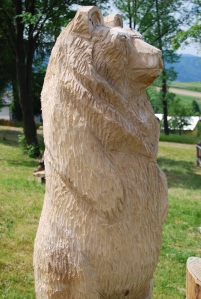In the third book of A Taste of Slovakia series, which I’m planning to publish towards the end of September, there will be a chapter on Slovak weddings. When researching online sources and numerous books of Slovak folklorists and ethnologists, I came across recipes and ancient photos of cakes that you won’t see on wedding tables today.
Depending on the region, they would be called radostník, poklona, baba, calta, brány, mrváň, vrtaň or kuch. This large and highly decorative cake was made and given to the bride by her godmother as a wedding gift. It would be ceremoniously carried in the wedding procession and placed on the table in front of the newly-weds. At the end of the dinner party, which invariably lasted until small hours, the cake would be divided among all guests.
Whatever it was called, the dough for the cake was yeast-based, sweet and buttery, with raisins or other dried fruit added in some variations. The cake was lavishly decorated with ribbons, paper flowers, rosemary and figures modelled from plain dough.
I wanted to get a decent photo of this old-style wedding cake for my book, but it is rarely made today. A cake of this size and shape is sometimes shown in regional folk festivals, but because all these events were cancelled during the Covid pandemic, I had to find different ways. It looked a daunting task to accomplish by myself, so I joined forces with the local art school. They are also helping me with illustrations for the book.
We made a plan with the art teacher: I would bake the base of the cake, she would take care of the decorating part. Under the teacher’s guidance, her students created some truly wonderful pieces from a simple dough made of flour, water and salt.
We let the dough pieces dry at room temperature for a week. Then I took them home and put them in the oven at 125°C for 2 hours. I was quite apprehensive about baking the cake. I had made similar dough dozens of times before, but the whole thing had to look really good for the photo, and I couldn’t err on the taste side either: it had been agreed with the teacher and the children that they would be allowed to eat the cake once it was put together and photographed. I chose a recipe using 1 kilo of the flour only, though some recipes I had found in old books were for 12 kilos: the size of the cake really depended on the number of wedding guests.
I chose a recipe using 1 kilo of the flour only, though some recipes I had found in old books were for 12 kilos: the size of the cake really depended on the number of wedding guests.
I was a bit nervous when the date for the decorating session arrived, but my cake came out surprisingly well. Still warm, I carried it to the art school, which is just a couple of minutes’ walk from my home. The children were excited about adorning the cake with their dough ornaments. The enjoyment was even greater when the tasting part finally arrived after the photo shoot. If there is a space in the book, I put the recipe for the cake alongside the photos. You may not need it these days, but at least it will give you an idea how much time, creative energy and how many helping hands were needed to put together a wedding cake of this scale.
If there is a space in the book, I put the recipe for the cake alongside the photos. You may not need it these days, but at least it will give you an idea how much time, creative energy and how many helping hands were needed to put together a wedding cake of this scale.




